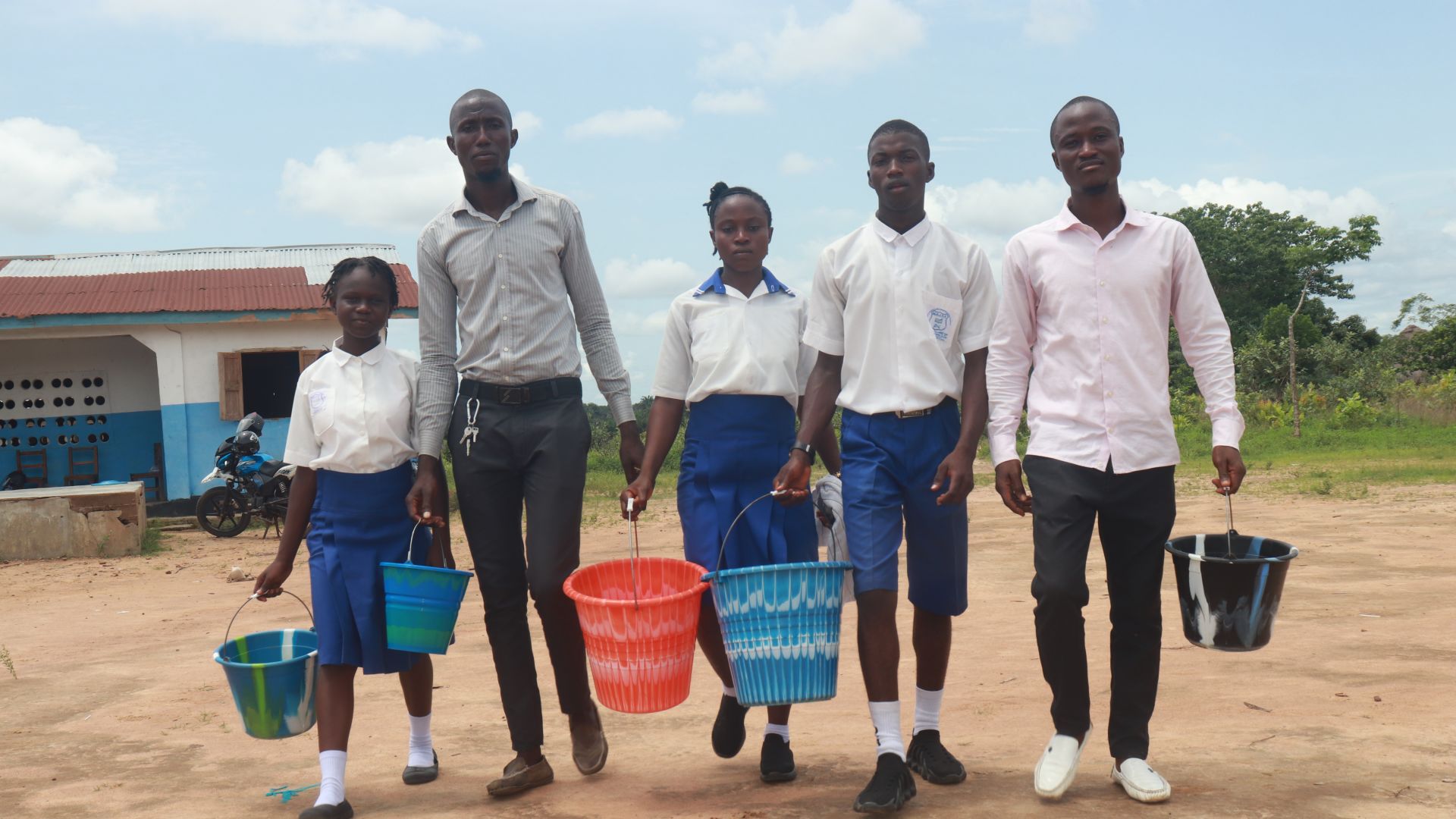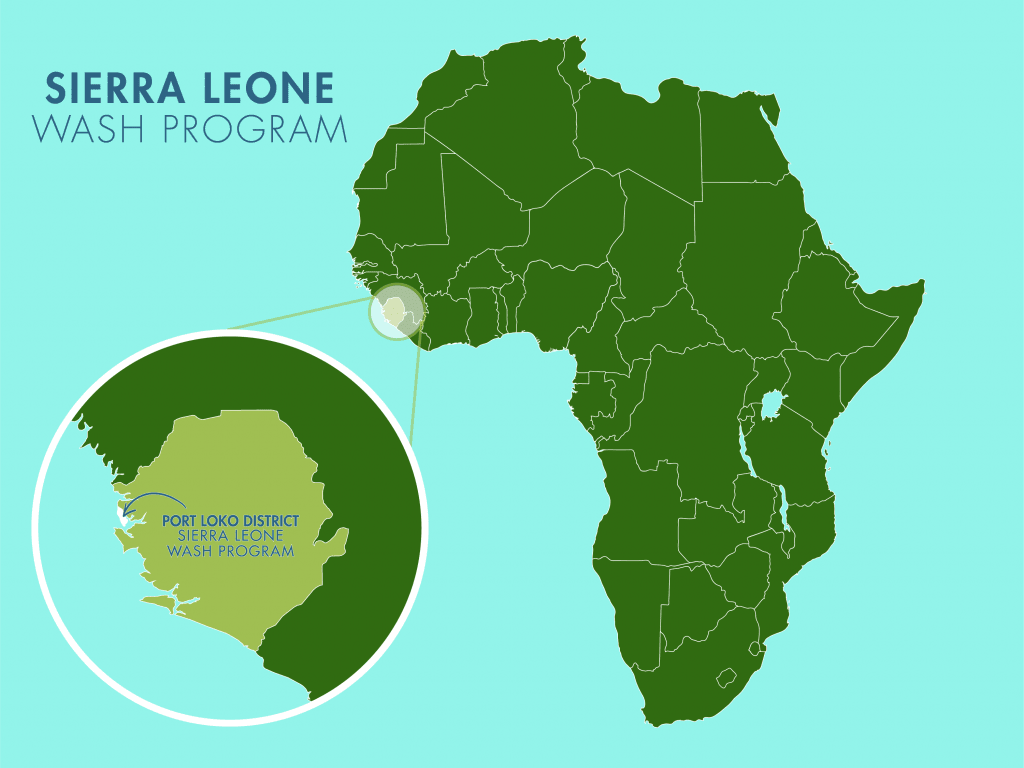The Mapillah Agricultural Jr. Secondary School is in the middle of a water crisis. With 260 students and 14 staff members needing water daily and no source on their school property, valuable learning time is wasted trekking to collect water from the community swamp, which bears more issues than it solves.

The swamp where students collect water.
Phillip James Allieu, Field Officer, shared about the troublesome condition of the swamp.
"The school relies on surface water in a swamp as a primary source of water since it is always accessible. The condition of the water, however, is very concerning. As an open surface water, it is exposed to all kinds of contaminants. The swamp is also used for crop irrigation, washing, and palm oil processing. The water is milky in color, and up to now, there has been no method applied to purify or clean it. Despite its outwardly contaminated and filthy appearance, the water is still used for drinking," he shared.
"The surrounding area is swampy, and during rainy seasons, the soil becomes slippery, making access very difficult, particularly for pupils or members of the community trekking with buckets of water on their heads. The bushy, narrow path increases the risk of falling and injury. When rain intensifies, the condition worsens. More waste and contaminants wash into the swamp, increasing the level of contamination of the water. There are also some visible signs of contamination at the water point that comprise animal access, laundry activities, bathing, and runoff from agriculture," he continued.

Students walking with their teachers to collect water.
Phillip continued, "Both the school and the community have reported cases of students skipping school due to frequent occurrences of diarrhea. The community health worker also pointed out that typhoid fever is yet another common disease among the community members."
The condition of the swamp poses a threat to the health of everyone who consumes water from it, but for the students, it also deprives them of their time and learning opportunities.
"There is a shortage of water in the school premises, which is causing delays in the implementation of the annual curriculum. It is hard for pupils to focus on their learning when they are thirsty or need to use [the] toilet facilities. The need to leave the classroom to cover a long distance to fetch water from the swamp is demotivating to many of the pupils. Most pupils get upset when selected to go for water, which negatively influences their interest and motivation towards learning. This ultimately influences their performance during exams, such as test scores," Phillip reported.
Seventeen-year-old Adamsay is all too familiar with the daily challenges presented when she has to waste her time collecting water from the swamp, and longs for things to change.

Adamsay collects water from the swamp.
"The long distance and bad road to the swamp are challenging, and I must be careful not to be hurt while I carry water on my head. When the water level is low, the water becomes filthy and difficult to fill a bucket. This delays my time in fetching water. It takes me more time fetching water from the swamp because of the long distance and sometimes low levels of water," lamented Adamsay.
"Getting water to school in the morning is something I never prefer. I get upset when I fetch water from the swamp. The long distance and rough roads make fetching water very difficult. When I am in school, as well as at home, I am worried because there is not sufficient water for drinking, latrine [use], and other needs. When water is not accessible, I worry, knowing that I could be among the others chosen to fetch it," she continued.
"I usually take a task to fetch water early in the morning prior to attending school, but when I am fetching water, I lose my study time. Although I can copy notes from my classmates, I do not have the explanations and my knowledge of the topic, and later, my performance during the exam is affected. Furthermore, it is highly difficult to get water from the swamp and uses a lot of energy. After spending such long hours making such an exhausting trip, I tend to struggle in class and become sleepy most of the time," Adamsay exclaimed.

Adamsay dreams of becoming a lawyer, but without access to clean water, that dream remains nearly unattainable.
Adamsay and her classmates urgently need a reliable, accessible source of clean drinking water on their school campus, so they can stay healthy, attend class consistently, and focus on learning to build a brighter future.
Steps Toward a Solution
Schools without reliable, on-premises water access often rely on students to fetch and carry water, leading to rationing and uncertainty about water quality. The water is typically poured into a communal storage tank and used by the entire school. With children carrying water from all different sources, it is also impossible for teachers and staff to know exactly where the water comes from and how safe it is to drink.
A new water point will be located on-premises at the school to ensure accessibility, reliability, and safety for students, teachers, and staff while meeting our school coverage goals. Having water available at the school allows children to drink, wash hands, and use sanitation facilities without leaving school grounds, preventing disruptions to lessons and reducing safety risks. A dedicated source increases water availability, reduces reliance on stored water, minimizes rationing, and ensures confidence in the safety of the water. This means staff and students are healthier, and their lessons aren’t disrupted, contributing to a better education!
Our technical experts worked with the school leadership and local community to identify the most effective solution to their water crisis. They decided to drill a borehole well, construct a platform for the well, and attach a hand pump.
Well
Abundant water often lies just beneath our feet. Aquifers—natural underground rivers—flow through layers of sediment and rock, offering a constant supply of safe water. A borehole well is drilled deep into the earth to access this naturally filtered and protected water. We penetrate meters, sometimes even hundreds of meters, of soil, silt, rock, and more to reach the water underground. Once found, we construct a platform for the well and attach a hand pump. The community gains a safe, enclosed water source capable of providing approximately five gallons of water per minute. Learn more here!
School Education & Ownership
Hygiene and sanitation training are integral to our water projects. Training is tailored to each school's specific needs and includes key topics such as proper water handling, improved hygiene practices, disease transmission prevention, and care of the new water point.
To ensure a lasting impact, we support forming a student health club composed of elected student representatives and a teacher. These clubs promote hygiene practices schoolwide and keep handwashing stations well-stocked. This student-led model encourages a sense of ownership and responsibility.
Safe water and improved hygiene habits foster a healthier future for everyone in the school and the surrounding community.

 Borehole Well and Hand Pump
Borehole Well and Hand Pump
 Rehabilitation Project
Rehabilitation Project
















